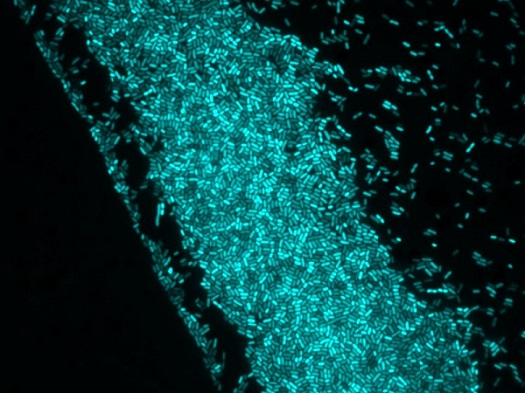
Bacterial resistance to antibiotics is a growing challenge for the healthcare and environmental sectors. Bacterial persistence is usually the first step leading to resistance, which involves a change in an organism’s genome.
In the future, it may be possible to address antibiotic persistence and resistance by using light to regulate bacterial response to antibiotics. A technique developed at the Polytechnic University of Milan (Politecnico di Milano), by a team participating in the Engineering of Bacteria to See Light (EOS) project, allows bacteria to sense light and convert light energy into electrical signals across the bacterial membrane, without the need for genetic modification.
To demonstrate photocontrol of bacterial membrane potential, the researchers attached phototransducing molecules to bacterial surfaces to make the bacteria light-responsive. When the researchers exposed the phototransducers to light, the electrical potential of the bacterial membrane changed.
The researchers used Ziapin2, a photoswitchable chemical compound, with two broad-spectrum antibiotics, Kanamycin and Ampicillin. These antibiotics have different modes of activation. Kanamycin requires cytosolic uptake to inhibit protein synthesis, while Ampicillin targets cell wall polymerization at the cell envelope.
When the researchers exposed B. subtilis to Kanamycin and Ziapin2 through photoactivation with 470-nm light, the previously lethal effects of Kanamycin were markedly reduced. In contrast, Ampicillin-treated samples remained largely unaffected by light-induced membrane modulation.
“This interplay between light and electrical signaling allows us to control key biological processes such as movement, biofilm formation, and antibiotic sensitivity,” professor Giuseppe Maria Paternò said. “By manipulating the membrane potential on demand, we can influence antibiotic uptake and restore or even enhance the effectiveness of treatments against resistant strains.”
Possible applications for the technique include developing next-generation antimicrobial platforms that use light to target resistant pathogens, and biocompatible, light-guided “bacterial robots” capable of delivering drugs to specific areas of the body — even the areas that are hard to reach, such as the gastrointestinal tract.
More broadly, the potential to modulate and control the interaction between bacterial cells and antibiotics using light and synthetic photoswitches, without genetic engineering, in real time, represents a first step in developing a new approach to combating antibiotic resistance.
In the future, photoswitchable chemical compounds could be membrane-targeted and tailored to work with different classes of antibiotics, advancing bacterial bioelectric regulation and its applications in antimicrobial therapies.
Bio Photonics Research Award
Visit: biophotonicsresearch.com
Nominate Now: https://biophotonicsresearch.com/award-nomination/?ecategory=Awards&rcategory=Awardee
#MeatAnalysis #FluorescenceTech #FoodQuality #FoodSafety #SpectroscopyInFood #MeatAuthentication #RapidDetection #FoodScience #MeatFreshness #MolecularDetection #FoodIndustryInnovation #NonDestructiveTesting #FoodMonitoring #SpectroscopyApplications #QualityControl #AdvancedSpectroscopy #MeatSpoilageDetection #FoodIntegrity #SmartFoodTesting #RealTimeAnalysis #FoodAuthenticity #FoodSafetyInnovation #SpectroscopyResearch #NextGenFoodSafety #InnovativeFoodScience,
In the future, it may be possible to address antibiotic persistence and resistance by using light to regulate bacterial response to antibiotics. A technique developed at the Polytechnic University of Milan (Politecnico di Milano), by a team participating in the Engineering of Bacteria to See Light (EOS) project, allows bacteria to sense light and convert light energy into electrical signals across the bacterial membrane, without the need for genetic modification.
To demonstrate photocontrol of bacterial membrane potential, the researchers attached phototransducing molecules to bacterial surfaces to make the bacteria light-responsive. When the researchers exposed the phototransducers to light, the electrical potential of the bacterial membrane changed.
The researchers used Ziapin2, a photoswitchable chemical compound, with two broad-spectrum antibiotics, Kanamycin and Ampicillin. These antibiotics have different modes of activation. Kanamycin requires cytosolic uptake to inhibit protein synthesis, while Ampicillin targets cell wall polymerization at the cell envelope.
When the researchers exposed B. subtilis to Kanamycin and Ziapin2 through photoactivation with 470-nm light, the previously lethal effects of Kanamycin were markedly reduced. In contrast, Ampicillin-treated samples remained largely unaffected by light-induced membrane modulation.
“This interplay between light and electrical signaling allows us to control key biological processes such as movement, biofilm formation, and antibiotic sensitivity,” professor Giuseppe Maria Paternò said. “By manipulating the membrane potential on demand, we can influence antibiotic uptake and restore or even enhance the effectiveness of treatments against resistant strains.”
Possible applications for the technique include developing next-generation antimicrobial platforms that use light to target resistant pathogens, and biocompatible, light-guided “bacterial robots” capable of delivering drugs to specific areas of the body — even the areas that are hard to reach, such as the gastrointestinal tract.
More broadly, the potential to modulate and control the interaction between bacterial cells and antibiotics using light and synthetic photoswitches, without genetic engineering, in real time, represents a first step in developing a new approach to combating antibiotic resistance.
In the future, photoswitchable chemical compounds could be membrane-targeted and tailored to work with different classes of antibiotics, advancing bacterial bioelectric regulation and its applications in antimicrobial therapies.
Bio Photonics Research Award
Visit: biophotonicsresearch.com
Nominate Now: https://biophotonicsresearch.com/award-nomination/?ecategory=Awards&rcategory=Awardee
#MeatAnalysis #FluorescenceTech #FoodQuality #FoodSafety #SpectroscopyInFood #MeatAuthentication #RapidDetection #FoodScience #MeatFreshness #MolecularDetection #FoodIndustryInnovation #NonDestructiveTesting #FoodMonitoring #SpectroscopyApplications #QualityControl #AdvancedSpectroscopy #MeatSpoilageDetection #FoodIntegrity #SmartFoodTesting #RealTimeAnalysis #FoodAuthenticity #FoodSafetyInnovation #SpectroscopyResearch #NextGenFoodSafety #InnovativeFoodScience,
Comments
Post a Comment